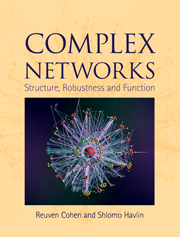Book contents
- Frontmatter
- Contents
- 1 Introduction
- PART I RANDOM NETWORK MODELS
- PART II STRUCTURE AND ROBUSTNESS OF COMPLEX NETWORKS
- 6 Distances in scale-free networks: the ultra small world
- 7 Self-similarity in complex networks
- 8 Distances in geographically embedded networks
- 9 The structure of networks: the generating function method
- 10 Percolation on complex networks
- 11 Structure of random directed networks: the bow tie
- 12 Introducing weights: bandwidth allocation and multimedia broadcasting
- PART III NETWORK FUNCTION: DYNAMICS AND APPLICATIONS
- Appendix A Probability theoretical methods
- Appendix B Asymptotics and orders of magnitude
- Appendix C Algorithms for network simulation and investigation
- References
- Index
8 - Distances in geographically embedded networks
from PART II - STRUCTURE AND ROBUSTNESS OF COMPLEX NETWORKS
Published online by Cambridge University Press: 05 August 2013
- Frontmatter
- Contents
- 1 Introduction
- PART I RANDOM NETWORK MODELS
- PART II STRUCTURE AND ROBUSTNESS OF COMPLEX NETWORKS
- 6 Distances in scale-free networks: the ultra small world
- 7 Self-similarity in complex networks
- 8 Distances in geographically embedded networks
- 9 The structure of networks: the generating function method
- 10 Percolation on complex networks
- 11 Structure of random directed networks: the bow tie
- 12 Introducing weights: bandwidth allocation and multimedia broadcasting
- PART III NETWORK FUNCTION: DYNAMICS AND APPLICATIONS
- Appendix A Probability theoretical methods
- Appendix B Asymptotics and orders of magnitude
- Appendix C Algorithms for network simulation and investigation
- References
- Index
Summary
We now address the geometrical properties of the networks, arising from their embedding in Euclidean space (see Section 4.6). For this purpose, it is useful to consider the spatial arrangement of the networks as measured both in a Euclidean metric and in chemical space. The chemical distance l between any two nodes is the minimal number of links between them (shortest path). Thus, if the distance between the two nodes is r, then l ˜ rdmin defines the shortest path exponent dmin. We will see that for scale-free networks embedded in d > 1 lattices, dmin < 1, contrary to all known fractals and disordered media where dmin ≥ 1. Nodes at chemical distance l from a given node constitute its lth chemical shell. Thus, the number of (connected) nodes within radius r scales as m(r) ˜ rdf, defining the fractal dimension df. Likewise, the number of (connected) nodes within chemical (hop) radius l scales as m(l) ˜ ldl, which defines the fractal dimension dl in chemical (hop) space. The two fractal dimensions are related: dmin = df/dl [BH96, bH00, SA94]. Note that dmin has a meaning only when the network is embedded in Euclidean space. In networks that are not embedded, the relation between M(l) and l exists, but it can only be a power law when the networks are fractals (Chapter 7) or at the percolation threshold (Chapter 10).
- Type
- Chapter
- Information
- Complex NetworksStructure, Robustness and Function, pp. 88 - 90Publisher: Cambridge University PressPrint publication year: 2010



